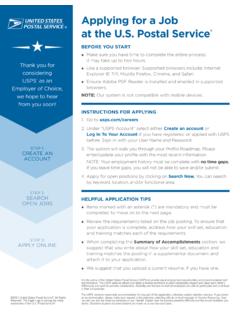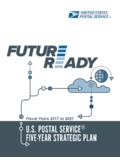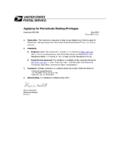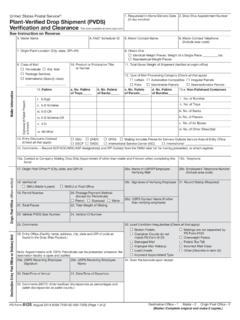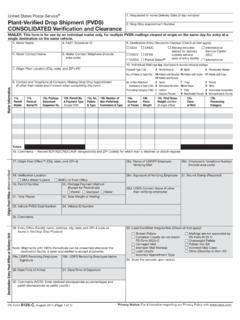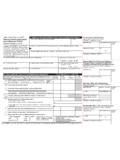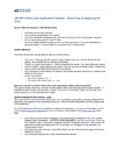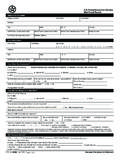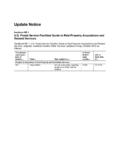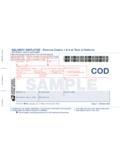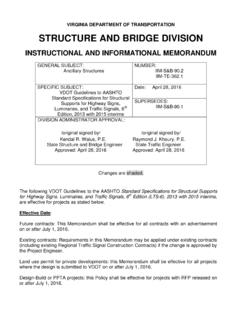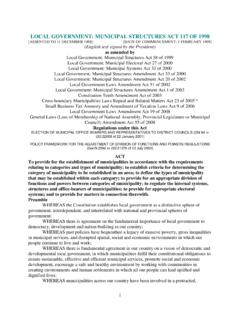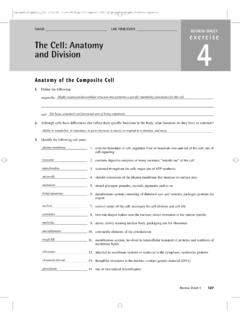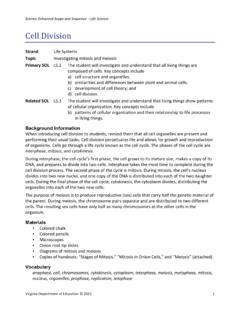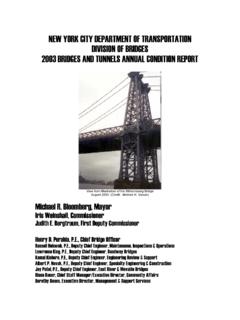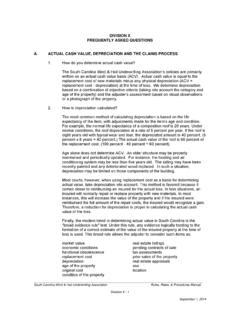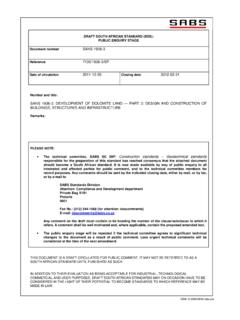Transcription of 1 Organizational Structures - USPS
1 1 organizational structures 110 General Information 111 Purpose Objectives The Organizational Structures policies of the Postal Service are established to meet the following objectives: a. Support the mission of the Postal Service. b. Ensure there is no duplication of jobs, functions, or responsibilities within or between Organizational Structures . c. Ensure the relevance and consistency of Organizational Structures and staffing. Note: See for definitions of Organizational terms. Chapter Content The content of this chapter: a. Documents the principles to establish Organizational Structures and staffing and describes the programs used to monitor and assess them. b. Establishes guidelines, policies, and procedures for implementing changes in Organizational Structures and staffing patterns, and it describes factors to be considered in making decisions related to Organizational changes.
2 In view of functional diversity, varying work requirements, and the wide range of operational circumstances, factors are considered and decisions are reached on a case-by-case basis. Importance of Concepts Organizational design operates on the basis of standard Organizational Structures and staffing criteria. Postal Service managers must be aware of the concepts applied in evaluating Organizational change requests so that they can: a. Make informed decisions when requesting Organizational changes. b. Submit appropriate documentation to support proposed changes. c. Understand the basis upon which their requests will be reviewed and evaluated. March 2018 1. 112 Organizational Structures 112 Responsibilities Headquarters Employee Resource Management within Human Resources at Headquarters has overall responsibility for the control of Organizational Structures and staffing for the Postal Service.
3 This includes: a. Developing and implementing Organizational management policies and programs for bargaining unit and nonbargaining unit positions. b. Designing programs and procedures for auditing and assessing existing Structures and staffing. c. Providing the capability to plan for the long-term Organizational development of the Postal Service in response to technological and environmental changes. Areas The area Human Resources manager: a. Serves as an advisory resource on matters relating to field organizations. b. Monitors compliance with approved staffing and Structures for field units. Managers All levels of managers in the Postal Service are responsible for: a. Planning and implementing administrative and operating methods that comply with Postal Service Organizational Structures and staffing policies. b. Reviewing the Structures and staffing of their organizations and recommending changes according to the instructions in this chapter.
4 113 Definitions Organizational Terms a. Activity a group of related (but possibly heterogeneous) tasks that constitute an easily defined operation or service which may be performed by an employee or group of employees. b. Function a principal method of devising work. A function may be a single activity, but is more commonly a group of related activities placed together under one responsibility. Functions are categorized as major or minor as follows: (1) Major function a group of activities that has a direct impact on the overall mission of the Postal Service. (2) Minor function a group of activities that has an indirect impact on the mission of the Postal Service. 2 ELM 44. Organizational Structures c. Organizational structure the formal relationship that: (1) Reflects the Organizational units within a given group and the pattern of work to be accomplished by the employees in the organization.
5 (2) Delineates responsibilities and reporting relationships; and (3) Creates a rational division of work. The Organizational structure should respond to the needs of the organization and foster the achievement of its objectives. When there is a basic change in the amount or kind of work to be done or in the assignment of the work to the positions involved, the Organizational structure should be changed. d. Organizational unit an entity in which the necessary activities are divided into segments small enough to be managed or supervised by one person. An autonomous unit operates under a manager with the discretionary decision-making responsibility (see ). e. Program a specialized, continuing endeavor consisting of a group of selected projects and activities related to one another within a major function. f. Staffing the number and types of positions within an organization, typically determined by criteria, guidelines, and standards.
6 Basic Managerial Positions Basic managerial positions are as follows: a. Installation head or manager one who plans, organizes, directs, guides, controls, and evaluates the efforts of subordinate managers, employees, or both to achieve Organizational goals. b. Supervisor one who has a direct responsibility for ensuring the accomplishment of work through the efforts of others. Normally, a supervisor has no subordinate employees with managerial responsibility for others. Organizational Entities Organization entities include the following: a. Executive vice president organization an Organizational entity in Headquarters that exercises managerial and directive control over one or more vice president organizations or serves as a member of the senior management team. b. Vice president organization an Organizational entity in Headquarters with responsibility for major heterogeneous functions having service- wide impact.
7 C. Headquarters unit an Organizational entity in Headquarters managed by an executive and subordinate to a vice president or a manager with responsibility for one or more major homogeneous functions having service-wide impact. d. Headquarters-related field unit an Organizational entity that performs a major function or group of minor functions, reports directly to a Headquarters manager, and resides outside the Headquarters building. March 2018 3. Organizational Structures e. Service center an Organizational entity that reports directly to a manager at Headquarters and resides outside the Headquarters building. f. Service office an Organizational entity that performs an activity or group of activities, usually to support a service center. g. Area office an Organizational entity that has responsibility within a specified geographical area for major heterogeneous functions having area-wide impact.
8 These functions include oversight of: (1) Subordinate districts, (2) Processing and distribution centers, (3) Network distribution centers, (4) Airport mail centers, (5) International service centers, and (6) Remote encoding centers. h. District office an Organizational entity subordinate to an area, with responsibility for major heterogeneous functions having district-wide impact, including oversight of subordinate Post Offices and delivery distribution centers. i. Processing and distribution center (P&DC) an Organizational entity, subordinate to an area, with significant responsibility for the processing and distribution of mail for a geographic area. A P&DC may have one or more reporting facilities. j. Processing and distribution facility (P&DF) an Organizational entity, generally subordinate to a P&DC, that has responsibility for the processing and distribution of mail for a geographic area.
9 K. Network distribution center (NDC) an Organizational entity, generally subordinate to an area, within a three-tier system of distribution of Standard Mail, periodicals, and packages. Some NDCs serve as consolidation points for truckload volumes. l. Surface transfer center (STC) an Organizational entity, generally subordinate to an area, designed to distribute, dispatch, consolidate, and transfer First-Class Mail , Priority Mail , and periodicals within a specialized surface transportation network. m. Logistics and distribution center (L&DC) an Organizational entity, generally subordinate to a district, engaged in the receipt, unloading, sorting, loading, dispatch, and transportation of a variety of mail products for a designated service area. n. Remote encoding center (REC) an Organizational entity, generally subordinate to an area, that processes video images of partially resolved or script letter mail for the P&DCs.
10 O. International service center (ISC) an Organizational entity that distributes and dispatches international mail received from a designated service area to specific foreign countries or to gateway exchange offices. 4 ELM 44. Organizational Structures 121. p. Post Office an Organizational entity subordinate to a district, and perhaps also an administrative Post Office, managed by a Postmaster, with responsibility for: (1) Customer services, (2) Local delivery, (3) The receipt and dispatch of all classes of mail, and (4) In some instances, processing and distribution of mail for other Post Offices in the surrounding geographic area. A Postmaster may be responsible for the operation of more than one facility, and duties may be performed by designated subordinate personnel at the direction of the Postmaster, including when the Postmaster is not physically present. q. Remotely Managed Post Office (RMPO) a Post Office that: (1) Offers part-time window service hours, (2) Is staffed by a Postal Service employee, and (3) Reports to an Administrative Post Office.
